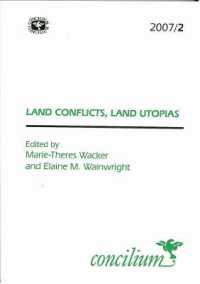- ホーム
- > 洋書
- > 英文書
- > Science / Mathematics
Full Description
This book discusses the cross-talk between plants and microbes in the rhizosphere. The rhizosphere is the hotspot of microbial activities that influence plant growth and crop yield. The rhizosphere-residing microbes include the nitrogen-fixing rhizobia, mycorrhizal fungi, antibiotic-producing bacteria, antagonistic, plant-beneficial fungi, and entomopathogens. The three-way cross-talk among the plants, the pathogens and other microbes involves signaling molecules, metabolites, and physical interactions. The book also describes deleterious and beneficial aspects of this communication between plants and microbes. Plants program the local microbiome near their roots, and the microbial community has a profound influence on the functioning of the plant. This complex communication makes the collection of chapters a timely one, because the diverse subjects are linked by their focus on the molecular language of plant-microbe cross-talk.
This timely and informative book is useful for students and researchers in the fields of microbiology, soil biology, and plant pathology.
Contents
Chapter 1 - Plant-microbe crosstalk in the rhizosphere: Introductory remarks.- Chapter 2 - How plants modulate their rhizosphere microbiome.- Chapter 3 - Strigolactone signalling and plant-microbe communications.- Chapter 4 - The role of phytohormones in cross-communication between plants and rhizo-microbes.- Chapter 5: Quorum sensing in the rhizosphere.- Chapter 6 - Metabolomics approaches for studying the Trichoderma-plant interactions.- Chapter 7 - Cross-talk between wilt-causing fungi, plants and their microbiome.- Chapter 8 - Biocontrol from the rhizosphere: probiotic pseudomonads.- Chapter 9 - Plant microbiome modulation through seed coating: A novel approach for a smart and efficient microbial delivery.- Chapter 10 - Trichoderma rhizosphere competence, suppression of diseases and biotic associations.- Chapter 11 - Ectomycorrhizal symbiosis: from genomics to trans-kingdom molecular communication and signaling.- Chapter 12 - Fungal effector proteins: Molecular mediators of fungal symbionts of plants.







